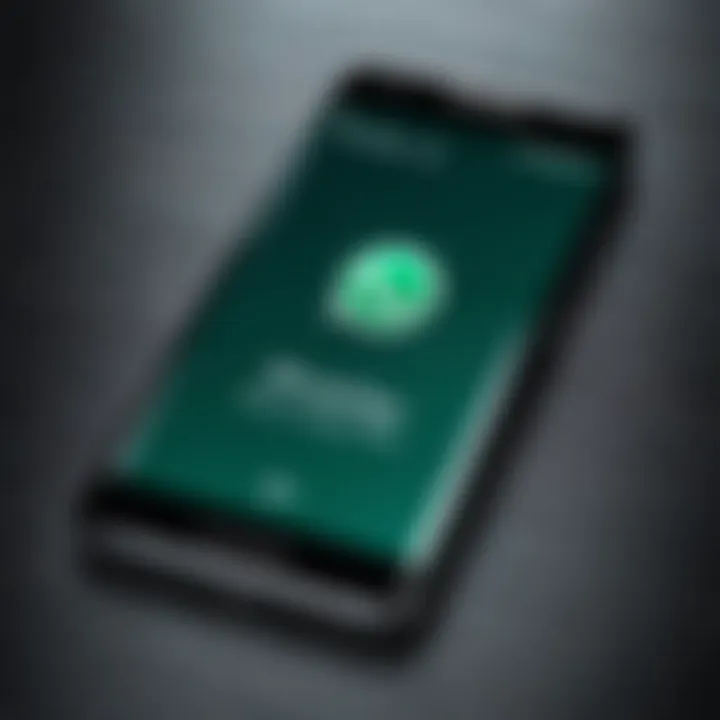Step-by-Step Guide to Install WhatsApp on Google Devices


Intro
In today's world, communication is often just a tap away, thanks to apps like WhatsApp. Installing this popular messaging service on devices powered by Google services can streamline your ability to connect with friends, family, and colleagues. This process seems simple, but there are several nuances worth noting to ensure a smooth setup from start to finish. Below, we delve into the key aspects of this installation, from the technology behind it to practical tips for troubleshooting.
Overview of the Technology
Key specifications
WhatsApp is designed for a wide range of devices, but its performance on Google devices such as Google Pixel or even Android tablets is noteworthy. Most modern Google devices run on Android, a flexible operating system that often comes with useful features enhancing WhatsApp functionality.
Operating System Compatibility:
If you are using Android 4.1 or later, you're good to go! WhatsApp offers seamless integration with most Google devices, ensuring that you can enjoy all its features.
Storage Requirements:
At minimum, WhatsApp needs around 100MB of storage for the app itself. Depending on your chat's multimedia files, the app’s data may expand over time. Be sure your device has enough space.
Unique selling points
WhatsApp distinguishes itself with end-to-end encryption, ensuring your messages stay private. Moreover, the app allows voice and video calls, making it a versatile tool not just for texting but also for real-time discussions.
These elements come together, presenting WhatsApp as an indispensable app for Google device users.
Design and Usability
Material used
While WhatsApp is a software application and not a physical product, its design mirrors the aesthetics of typical Google service interfaces. It’s clean, simple, and highly user-friendly, which plays a vital role in the overall user experience. This design ethos resonates with Google's approach, prioritizing accessibility and ease of use.
Ergonomics and usability
The interface of WhatsApp is intuitive, designed in a way that even non-tech-savvy users can navigate it without steep learning curves. Essential features like chats, calls, and settings are easily accessible within a scroll or a tap. Customization options, such as stickers and themes, also enhance the overall experience, allowing users to express their personality.
"The real beauty of WhatsApp lies in its ability to keep people connected across distances, making every conversation meaningful."
The End
Installing WhatsApp on a Google device is not just an exercise in technology familiarity; it's about enhancing one's communication capabilities in a fast-paced digital world. By understanding the technology specifications and usability aspects, users can set themselves up for a successful installation and a rewarding chat experience. The subsequent sections will equip you with the detailed steps and best practices to embark on this technical journey.
Understanding WhatsApp
In today’s interconnected world, understanding the functionality and significance of WhatsApp is imperative for anyone seeking effective communication. WhatsApp isn't just another messaging app; it has transformed how we connect with family, friends, and colleagues. Its ease of use and plethora of features have made it a staple in the lives of millions worldwide.
What is WhatsApp?
WhatsApp is a messaging platform founded in 2009 that enables users to send text, voice messages, make voice and video calls, and share media effortlessly. Available on various devices, particularly those running Google services, it has effectively bridged the gap between traditional SMS and modern communication practices. Unlike typical SMS, WhatsApp uses the internet for message delivery, significantly reducing the cost of sending messages, especially for international communications.
Thus, it’s not surprising that more than two billion users worldwide rely on this platform daily. It combines simplicity with comprehensive functionalities, making it a go-to app for straightforward conversations and complex interactions alike.
Key Features of WhatsApp
WhatsApp is packed with features that enhance user experience beyond plain text messaging:
- End-to-End Encryption: This ensures that only you and the person you’re communicating with can read what is sent, adding a layer of security.
- Group Chats: You can create groups for discussions, planning, or even just casual chats, accommodating up to 256 participants.
- Voice and Video Calls: Making calls over the internet can save both time and money, allowing clear conversations at no extra charge.
- Multimedia Sharing: Users can share images, videos, documents, and other files instantly, facilitating seamless communication.
- WhatsApp Web: This feature allows users to access their chats through a web browser, keeping the conversation alive even when you are at your desk.
Each of these features serves to enhance the way we communicate, making it more interactive and versatile than ever.
Importance of WhatsApp in Modern Communication
WhatsApp plays a crucial role in modern communication by facilitating real-time interaction across distances. It breaks down geographical boundaries, allowing families spread across continents to remain in touch without substantial cost.
Additionally, many businesses have adopted WhatsApp as a platform for customer service and outreach. It provides a channel for immediate responses and customer engagement that traditional methods like email or phone calls simply can't match.
"With WhatsApp, people can connect on a more personal level, making interactions feel immediate and less formal."
As technology continues to evolve, its adoption in various sectors—whether educational, commercial, or social—underlines its significance. In essence, WhatsApp is not merely a messaging app; it represents a paradigm shift in how we interact and maintain relationships in a digital age.
Prerequisites for Installation
Before diving into the nitty-gritty of installing WhatsApp on your Google devices, it is crucial to understand the prerequisites for a smooth and successful installation process. Getting these initial elements right can save you a heap of trouble later on, ensuring that your experience with WhatsApp is seamless and enjoyable. The importance of prerequisites can't be overstated; they lay the groundwork for the installation process and help you avoid unnecessary hiccups.
Device Compatibility
Smartphones
When it comes to WhatsApp, smartphones are the primary choice for installation. Most users prefer smartphones because they are compact, portable, and user-friendly. Their main characteristic is their ability to stay connected on the go, making them an excellent choice for instantaneous communication.
A unique feature of smartphones is their touch interface, which contributes to a more interactive and engaging user experience. They come equipped with robust processors and ample RAM, allowing for fast loading times and smooth operation of apps like WhatsApp. However, it’s crucial to ensure your smartphone runs on a compatible operating system version, such as Android 4.0.3 or higher; otherwise, you might find yourself running into compatibility issues.
Tablets
Tablets also offer a wider screen experience, which can be beneficial while using WhatsApp. One of their key characteristics is their larger display compared to smartphones, providing a more enjoyable multimedia experience, like video calls or viewing images. They are particularly popular for users who engage in detailed conversations or those who prefer not to squint at smaller screens.
A unique aspect of tablets is their versatility. Owners can switch to various productivity apps seamlessly. Still, users should check that their tablet’s operating system is compatible with WhatsApp, as some models may run a variation of Android that does not support the app.
Computers
Installing WhatsApp on a computer can be a game changer, especially for those who work long hours in front of a screen. The standout characteristic of computers is their processing power and larger storage capacity, which can accommodate multiple apps running simultaneously without lag.
A notable feature of using WhatsApp on a computer is the ability to type messages faster using a keyboard, which often leads to more efficient communication. Yet, keep in mind, you must also install WhatsApp on your mobile device for the desktop version to function, as it relies on syncing your messages. Ensuring your computer's operating system, whether it be Windows or macOS, meets the WhatsApp desktop app requirements is essential to avoid potential installation roadblocks.
System Requirements
Operating Systems
Operating systems are at the heart of your device's functionality, and they play a vital role in running apps like WhatsApp. Android and iOS primarily dominate the mobile landscape. The key element here is making sure that your device runs a compatible version of these operating systems. WhatsApp requires at least Android OS 4.0.3 or iOS 9.0; anything below that might not support the latest features and updates.
A critical aspect of operating systems is their ability to enhance user experiences through user interface design and optimization. If your operating system is up to date, it can better support applications, reducing bugs and glitches during usage.
Storage Space
Having enough storage space is another crucial requirement. It’s not just about the initial download of WhatsApp; it’s also about future updates, media sharing, and conversations that can take up significant space over time. Users should ideally check that they have at least 100MB of free space before proceeding with the installation, though more space is always better for a smooth experience.
The unique feature about storage space is its impact on performance. Low storage can result in an oversaturated device, leading to slow performance and potential crashes, which is the last thing you want when you need to communicate quickly.
Internet Connectivity


Lastly, but by no means least, is internet connectivity. WhatsApp relies heavily on a stable internet connection to send messages, make calls, and send media files. A Wi-Fi connection is preferable, but mobile data will also do the trick if you have sufficient data allowance.
The key characteristic of internet connectivity is its direct impact on responsiveness. A fast connection allows for rapid message delivery and high-quality video calls, while a slow connection can lead to frustrating delays and dropped calls. Ensuring you have a reliable internet connection before installing WhatsApp is paramount to ensuring that you can fully utilize all the app's features after installation.
Downloading WhatsApp from Google Play Store
Downloading WhatsApp from the Google Play Store is a crucial step for anyone looking to enhance their communication through this widely-used app. By accessing the Play Store, users ensure that they are getting a secure and official version of WhatsApp. This application handles everything from instant messaging to video calls, making it a cornerstone of modern connectivity.
When it comes to the simplicity of installation, Google Play Store leads the pack. It eliminates the uncertainties often associated with downloading apps from unfamiliar sources. Moreover, downloading from the Play Store helps maintain the app’s integrity through regular updates, ensuring that users are equipped with the latest features and security patches.
Navigating the Google Play Store
Navigating the Google Play Store is quite user-friendly, even for those who might not consider themselves tech-savvy. Upon opening the Play Store, users are greeted with a familiar layout - a host of apps categorized by various sections, alongside recommendations based on personal usage.
It’s all about following a couple of simple steps:
- Open the Google Play Store: This can usually be found on your device's home screen or in the app drawer.
- Familiarize Yourself with the Interface: Exploring the main sections such as 'Top Free Apps' or 'New Releases' can provide insight into popular choices.
Getting comfortable here means users can find not just WhatsApp, but other apps they may find useful.
Searching for WhatsApp
Searching for WhatsApp in the Google Play Store is straightforward. There’s a search bar at the top of the screen where you can type in "WhatsApp". Typing the name correctly, without any typos, ensures a quicker, more accurate search result.
A hit on the search icon will display relevant apps including WhatsApp Messenger. It's worthwhile to check user ratings and reviews displayed alongside the app icon. This can offer insights into any issues other users might have faced, which can be helpful.
Initiating the Download
Once you locate the app, you’re a step away from installing WhatsApp. Tapping the "Install" button prompts the download to begin, which is where the magic really starts to happen.
Confirming Permissions
Confirming permissions is a vital part of the WhatsApp installation process. WhatsApp requests access to features such as contacts, photos, and storage on your device. This step might seem tedious, however, it serves an important purpose. Giving these permissions allows WhatsApp to function effectively, enabling you to send and receive messages, share media files, and maintain a connected experience.
One notable aspect is that every permission request includes a brief explanation of its necessity, so users can make informed decisions. While some may be wary of granting such permissions, realizing that these are essential for the app to operate enhances understanding.
Monitoring Download Progress
Keeping an eye on the download progress can be quite satisfying. A progress bar appears at the bottom of the screen, indicating how much of the app has been downloaded and how much longer it will take. This feature is especially beneficial to users who might get anxious waiting, providing immediate feedback on the installation status.
One key characteristic of monitoring download progress is transparency. This allows users to gauge their internet speed and adjust accordingly if the download seems sluggish. However, it's essential to maintain a stable internet connection during the download phase; otherwise, it may result in a frustrating experience.
Pro Tip: If your download is taking longer than expected, double-check your Wi-Fi connection. A weak signal can slow things down.
In short, downloading WhatsApp from the Google Play Store not only simplifies the installation process but also ensures that users are entering a secure environment tailored for effective communication. Following these outlined steps makes it smoother to enjoy the features WhatsApp has to offer.
Installing WhatsApp on Your Device
Installing WhatsApp on your device is more than just a matter of tapping an icon or completing an installation wizard. It marks the beginning of an enriched communication landscape where users can share thoughts, emotions, and experiences instantly. Understanding the nuances involved in this process plays a crucial role in maximizing one's ability to leverage the app’s full potential. Whether you’re using it for personal banter, professional collaborations, or managing group tasks, installing WhatsApp correctly ensures smooth functionality and connectivity in your digital interactions.
Installation Steps
Launching the Installation
Launching the installation is the first significant step in taking advantage of WhatsApp’s offerings. This step essentially sets the stage for the entire process. By initiating the installation, you indicate your readiness to engage in a modern communication platform. One of the key characteristics of launching the installation is the ease with which it can be done. With a few taps on the screen, users can initiate this journey toward improved communication.
A beneficial aspect of this phase is that it acts as a quick gateway. Users typically have multiple ways to launch the installation, whether through direct downloads or via the Google Play Store. However, each option comes with its unique advantages; for example, the Play Store option is generally safer as it minimizes risks associated with unverified third-party sources. Yet, one must remain mindful of specific permissions that the app requests upon launching, as these could limit or enhance the app’s performance on your device.
For those new to smartphones, the simplicity and familiarity of launching through the Play Store provides much-needed reassurance, allowing users to embark on this communication upgrade with confidence.
Completing Installation
Once the installation has been successfully launched, attention turns towards completing the installation. This step is just as pivotal as the launch; without it, the app remains dormant. Key here is understanding that completing the installation usually requires users to follow on-screen prompts, which guide them through the necessary steps to finalize the app setup.
A notable characteristic of completing the installation lies in its user-friendliness. Most users can tackle this process without any technical know-how. The combination of clear instructions and automatic updates simplifies potential headaches down the line. However, while this step generally appears straightforward, certain unique features—like requiring specific settings or permissions—can sometimes lead to installation errors if neglected.
The main advantage of completing the installation successfully is that it enables immediate access to WhatsApp’s features. As a result, users can start communicating right away, eliminating any downtime. Knowing these factors empowers the user and eases the transition into using this prominent messaging app.
Setting Up Your Account
Verifying Your Phone Number
With the installation behind you, setting up your account is the next crucial milestone. At the heart of this process lies the verification of your phone number, which confirms your identity within the app. This step is significant because it creates a link between you and your contacts, ensuring that the people you wish to communicate with can find you with ease.
A vital characteristic of this verification process is that it helps safeguard user accounts against unauthorized access. WhatsApp utilizes a simple yet efficient verification mechanism—sending a one-time code via SMS. This popular method provides a safety layer while still being relatively hassle-free for users.
In terms of unique features, the verification process can be both an advantage and a drawback. While the SMS method is efficient, users in areas with poor network coverage might experience delays or even missed codes, leading to frustration. Recognizing this allows users to prepare alternative verification methods, like an automated call, should issues arise.
Configuring Your Profile
After verifying your phone number, configuring your profile comes next. This step is vital as it shapes your identity within the app. When properly done, it allows your contacts to see your name and profile picture, making interactions feel more personal and connected.
A key characteristic of configuring your profile is how straightforward and intuitive it is. Users can easily upload a picture, set their name, and even add a status that reflects their current mood or activities. This feature not only fosters a sense of community but encourages more authentic engagements between users.
However, the unique element of this step lies in its dual role. While filling out your profile enhances connectivity, it also opens up discussions regarding privacy and security. Users must weigh the benefits of sharing personal information against the potential risks. Ensuring that profile settings align with personal privacy preferences is critical in today’s tech-driven environment.
Alternative Installation Methods
Many users prefer to jump through the usual hoops of downloading and installing apps from the Google Play Store. However, understanding alternative installation methods can be a lifesaver for those looking to sidestep potential hiccups or simply find a quicker path. In our case, we will delve into two unique routes: downloading the WhatsApp APK and using third-party app stores.
These methods provide flexibility, especially when the official store is unavailable or not functioning as it should. For those tech-savvy souls who know their way around apps, these methods are not just convenient but also broaden accessibility to the desired functionalities of WhatsApp without big fuss.
Downloading WhatsApp APK
Understanding APK Files


APK files, or Android Package files, are the packages used to distribute and install apps on Android devices. They often serve as a quick fix when users are unable to access apps from the Play Store, allowing them to install directly from an external source. This method can be particularly handy when the app version on the Play Store lags behind what the user wants to run due to regional restrictions or release delays.
What's noteworthy about APK files is that they bundle all necessary components, enabling users to install the application without the need for an internet connection post-download. However, this method does come with a caveat; downloading APKs from dubious sites can open the door to malware lurking in the shadows. Therefore, understanding where to find reliable APKs is crucial.
Pros:
- Quick access to the latest app versions
- Bypasses regional restrictions
Cons:
- Risk of downloading malicious files
- May require enabling installation from unknown sources
Safe Sources for APK Downloads
Finding a trustworthy source for downloading APK files is critical. Some well-known repositories like APKMirror and APKPure have garnered a reputation for vetting apps and maintaining cleanliness in their offerings. Using these safe havens for APK downloads significantly mitigates the risks associated with malware-infested files.
The key characteristic of these sites is their stringent quality checks, ensuring users receive what they expect—nothing less. When delving into a safe source, it’s reassuring to know that experienced developers are behind the curation of the applications listed. Always use caution when venturing off the beaten path, as you might find unverified sites claiming offers that seem too good to be true.
Advantages:
- Reliable curation reduces risk associated with downloads
- Access to diverse versions of apps
Disadvantages:
- Not all apps available, especially niche ones
- Encourages a reliance on external sites
Installing via Third-Party Stores
Evaluating Third-Party Stores
Third-party app stores present another avenue for accessing WhatsApp installations. However, before diving into these alternative markets, one must evaluate their credibility. Some stores, like Amazon's Appstore or GetJar, are known for their reliability and rigorous checks on app integrity. Ultimately, these sources can be a goldmine for those who prefer having a broader range of application options.
When scrutinizing a third-party store, key aspects such as user reviews, update frequency, and developer transparency are red flags or green lights to consider. Good stores tend to have user communities that share feedback and experiences, which can guide your choice effectively.
Points to consider:
- User reviews can spotlight issues with specific apps
- Frequent updates signify a proactive approach to security
Installation Process
Once a third-party store is selected and deemed reliable, the installation process often mirrors what one might find in the official Play Store. Just download the app, allow the required permissions, and voila, it’s installed. But here, too, lies the importance of ensuring that all permissions requested are truly needed for the functionality you desire.
Installing from third-party stores can also come with the risk of outdated apps that do not receive timely updates, potentially leaving users vulnerable to security flaws.
Key steps to ensure a smooth process:
- Select and Download: Choose the app store and find WhatsApp.
- Permissions: Carefully read through the requested permissions before affirming.
- Install: Tap install, wait for it to finish, and then launch WhatsApp.
Advantages:
- Wider selection of apps and versions
- May facilitate accessing modified versions of apps
Disadvantages:
- Risk of malware if the store is not credible
- Potential for buggy or old versions
Using alternative installation methods can not only expedite your path to WhatsApp but also empower you with a greater understanding of how apps function beyond the standard channels. It's important to approach these methods with a discerning eye while remaining mindful of the potential risks involved.
Troubleshooting Installation Issues
When it comes to installing WhatsApp, encountering a few hiccups is not uncommon. This section focuses on troubleshooting installation issues, an essential part of ensuring that users can enjoy uninterrupted communication. Knowing how to navigate these challenges is crucial for a seamless setup, allowing users to make the most of WhatsApp’s features without getting bogged down by technical problems.
Common Installation Problems
Sometimes, despite your best efforts, things don’t go as planned. Two common culprits often arise during the installation process: insufficient storage and incompatibility errors.
Insufficient Storage
Insufficient storage can be a real roadblock when trying to install WhatsApp. As people tend to save photos, videos, and heavy apps, devices can quickly become cluttered. This problem directly impacts your ability to install new applications. Simply put, WhatsApp requires a certain amount of free space to set up properly and function well. If your device has limited storage, it can lead to frustrating failures in installation.
Knowing how much storage you actually have can be a worthwhile exercise. Users might consider uninstalling unused apps or clearing out some old photos to make room. By addressing this issue, users not only create space for WhatsApp, they also enhance the overall performance of their device. So, keeping an eye on storage can save a lot of headaches down the line.
Incompatibility Errors
Incompatibility errors pop up when the version of WhatsApp you’re trying to install doesn’t align with your device's operating system. This could stem from trying to install on outdated software or hardware that doesn’t meet the app's requirements. In these cases, WhatsApp might refuse to install, leaving users in a bit of a bind.
Understanding your device specifications is key here. User can check for updates on their operating system, which can sometimes solve the problem in a jiffy. Keeping software up-to-date isn’t just a minor inconvenience but a crucial step to ensure seamless application installations and compatibility with new software features.
If you hit this snag, double-check that your device meets the current requirements for WhatsApp. It's a small step that carries significant implications for seamless communication.
Resolving Issues
After identifying a problem, the next step is resolution. There are often straightforward methods to fix common installation issues, two of which are clearing the cache and reinstalling the app.
Clearing Cache
Clearing cache is a handy technique when dealing with glitches. The cache stores bits of data from apps to help them run faster, but sometimes, it can get a bit too full or even corrupted, which hampers installation. By clearing the cache, you essentially wipe the slate clean, potentially boosting your device's responsiveness and solving lingering issues from previous installations.
Users can easily navigate to their settings and clear the app cache to ensure a smoother installation experience. This method can sometimes be overlooked, yet it’s a simple fix that can make a world of difference.
Reinstalling the App
If all else fails, reinstalling the app might just do the trick. This involves deleting WhatsApp completely from your device and then downloading it again from the Google Play Store or another safe source. Reinstallation can help reset the application and eliminate any corrupted files or incorrect settings that may have crept in.
It’s like taking a fresh shot at it. Not only does it clear up potential problems, it also allows users to start anew, ensuring all current features and updates are correctly installed. Though it may feel like a hassle, particularly if your messages and media haven’t been backed up, it often resolves lingering problems effectively.


"Most problems can be solved with a little patience and the right knowledge. In the world of tech, sometimes a simple restart can work wonders."
By familiarizing yourself with these troubleshooting methods, you position yourself to handle any installation issues that might come your way with confidence. Maintaining your device for optimal performance opens the door to a smooth WhatsApp experience. Keeping these approaches in your toolkit not only aids in installation but also enhances your overall engagement with technology.
Maintaining WhatsApp Post-Installation
Once you've successfully installed WhatsApp on your Google device, you're just getting started. It's not just about getting the app up and running; it's also about ensuring it continues to function smoothly. Maintaining WhatsApp post-installation is crucial for optimal communication. This involves keeping the app updated and managing notifications to tailor the experience to your personal preferences.
Updating WhatsApp Regularly
To keep WhatsApp running like a well-oiled machine, regular updates are essential. Each update typically includes bug fixes, performance improvements, and sometimes new features that can enhance your usage. When you install WhatsApp, you might think you're all set, but neglecting updates is like ignoring your car’s oil changes—we all know that’s a recipe for disaster.
To ensure you're on the latest version, you can set auto-updates in the Google Play Store. Just go to Settings > Auto-update apps and choose to update over Wi-Fi or any connection. If you'd rather play it by ear, check for updates manually. Open the Google Play Store, search for WhatsApp, and tap the "Update" button if it appears. With each update, you’re not just keeping up with the times; you’re also enhancing security measures against vulnerabilities.
Managing Notifications and Settings
WhatsApp is a bustling hub of conversations, allowing you to stay connected with groups, friends, and family. However, with great communication comes great distraction. This is where managing your notifications and settings becomes vital.
You don't want to be bombarded with notifications for every new message in a group chat, especially if you’re part of multiple vibrant discussions. To take control, head over to the app settings.
- Open WhatsApp.
- Go to Settings > Notifications.
- Tweak the options for message tones, vibrations, and pop-up notifications according to your liking.
You can also fine-tune notifications on a per-chat basis. Simply long-press on a chat, select "Mute notifications", and choose the duration. It’s a straightforward yet effective way to maintain your focus while still being reachable.
Furthermore, regularity in checking your privacy settings is just as essential. Tweaks made by WhatsApp can affect how your information is shared with others. Go to Settings > Account > Privacy to review options like "Last Seen" and "Profile Photo" visibility. Keeping your settings fresh not only maintains your comfort but also ensures that WhatsApp works in harmony with your lifestyle.
"Good management of WhatsApp notifications leads to a more manageable digital life."
Utilizing WhatsApp Features Effectively
Using WhatsApp effectively hinges on understanding its features, which are designed to enhance communication. By leveraging the app's capabilities, users can improve their messaging experience and stay more connected with their social circles, all while maintaining a level of engagement that's both efficient and enjoyable.
Creating and Managing Groups
Creating groups on WhatsApp is a powerful feature for both personal and professional interactions. Groups allow multiple members to communicate simultaneously, making it an ideal choice for families, friends, and work teams. Setting up a group is straightforward:
- Open WhatsApp and tap on the chat icon.
- Select "New Group". This option is usually at the top.
- Choose participants from your contacts to include in the group.
- Set a group name and optionally, a group image.
- Create the group by tapping on "Create".
Management of groups is equally important. As a group admin, you can set rules for the group, manage participants, and control notifications to limit distractions. For example, in a work group, you might want to restrict who can send messages or who can change the group description. Although intuitive, paying attention to these settings is critical to maintain a smooth flow of communication.
This aspect helps ensure that everyone stays on the same page and that the group's purpose is upheld, avoiding unnecessary clutter and confusion.
Exploring Multimedia Sharing
WhatsApp supports a variety of multimedia sharing options that enrich conversations. Whether it’s images, videos, or voice notes, these elements add a personal touch that plain text cannot convey. When you share files, consider the following guidelines:
- Image Sharing: High-resolution images can help capture moments vividly. Tap the attachment icon and select your images from the gallery. For a better experience, avoid sharing too many at once to keep the conversations flowing.
- Video Sharing: You can send videos up to 16 MB. Use the same attachment method to share videos. They can help convey experiences or moments better than words.
- Voice Messages: This is particularly useful when you’re short on time or need to express emotion. Record your message by holding the microphone icon and release to send.
By utilizing multimedia features, users can express thoughts and feelings in ways that plain text often fails to capture.
"Communication is not just about exchanging words; it’s about sharing experiences."
Every element of WhatsApp, from groups to multimedia sharing, is designed to foster connections. By exploring these features, users can create a more engaging environment that enriches their conversations, making WhatsApp an invaluable tool for communication in today’s tech-centric world.
Best Practices for Security and Privacy
In today's world, where our phones are practically an extension of ourselves, ensuring the security and privacy of your messaging app has become paramount. WhatsApp, with its widespread use, holds a treasure trove of personal information—chat histories, contacts, and multimedia files. By following best practices for security and privacy, you not only safeguard your data but also enhance your overall user experience. Failing to do so might put your information at risk, sometimes in ways you wouldn’t even anticipate. Below we explore the significance of these practices and how they can protect you.
Understanding Privacy Settings
WhatsApp offers a variety of privacy settings that give users control over who can see their information. This is crucial, because sharing personal details with the wrong people can lead to unwanted harassment or data breaches.
Here’s a quick rundown on how to navigate these settings:
- Profile Photo and Status: You can control who views your profile picture and status updates. Options are set to "Everyone" by default, but you might consider changing it to "My Contacts" or even "My Contacts Except…" for more privacy.
- Last Seen: This lets others know when you were last active. If you prefer not to share this information, you can turn it off by adjusting the settings. You can set it to "Nobody" to keep your activity under wraps.
- Read Receipts: When you read a message, the sender sees two blue ticks. If you’d rather keep this feature disabled, you can do so in privacy settings to avoid letting others know that you have read their messages.
Adjusting these settings doesn’t just affect personal contacts; it influences how much of your life you make accessible in the digital realm.
Enabling Two-Step Verification
Two-step verification is an important feature for anyone looking to strengthen the security of their WhatsApp account. Essentially, it adds an extra layer of protection, requiring not only your password but also a unique code sent to you when you log in from a new device. This makes it significantly harder for unauthorized users to access your account.
Here’s how to enable two-step verification:
- Open WhatsApp: Go to the app’s settings.
- Account Options: Select the "Account" option.
- Two-Step Verification: Tap on it, and then tap on "Enable."
- Set a PIN: You'll be asked to create a 6-digit PIN that you will need to enter whenever you register your phone number with WhatsApp again.
- Optional Email Address: You can even add an email address. This helps in case you forget your PIN, making the recovery process easier.
"Often, the simplest measures yield the best protection. Don’t overlook the importance of enabling two-step verification on WhatsApp—it’s a small step with a big impact!"
When it comes to security, it’s about being proactive rather than reactive. Following best practices can transform how you interact with your app and the world, allowing you to communicate without fear of data compromise.
Commonly Asked Questionss Regarding WhatsApp Installation
Understanding the frequently asked questions surrounding WhatsApp installation can be quite beneficial for users, especially those who might be new to the application or technology in general. This section aims to address common queries that arise during the installation process, providing clarity and assisting users in resolving potential issues effectively.
How long does the installation take?
The installation duration of WhatsApp on Google devices is relatively short, typically taking anywhere from a few seconds to a couple of minutes, depending on several factors:
- Internet Speed: A stable and fast internet connection ensures that the app downloads quickly. On a slow connection, the download might take longer.
- Device Performance: Older devices may take longer to process the installation compared to newer models, which are generally faster.
- Storage Space: If a device is running low on storage, the installation may stall as the device works to free up necessary space.
In general, most users can expect the installation to be completed in under five minutes if everything is functioning correctly. While waiting, it’s a good time to grab a cup of coffee or check your notifications, just don’t get distracted!
What if forget my verification code?
Forgetting your verification code can be a bit of a hassle but fret not; there are ways to recover from this snag. Here’s what you can do:
- Request a New Code: Simply click on the option to resend the verification code within the app. This will prompt a new one to be sent to your phone number via SMS or a phone call.
- Check Your Signal: Sometimes, poor cellular reception can delay the arrival of the code. Ensure your device has a good signal.
- Use the Same Number: Make sure you are trying to verify using the same phone number tied to your WhatsApp account. If you’re using a different number, the code won’t reach you.
- Time It Out: If you’ve requested multiple codes in a short span, you may need to wait a bit, as WhatsApp imposes rate limits on code requests.
If problems persist, it could be worth checking for updates or reinstalling the app.
Important: Always be cautious and remember that WhatsApp verification codes are sent via text or call only; never share them with others, as this can put your account at risk.







